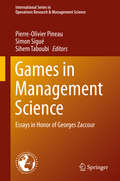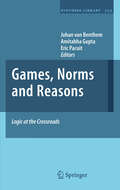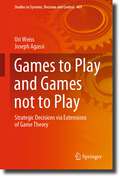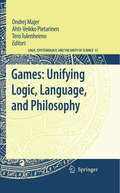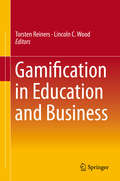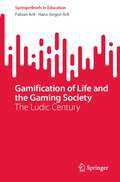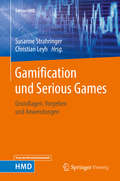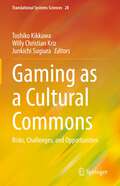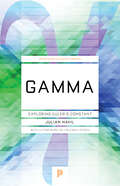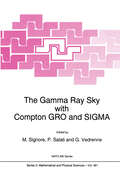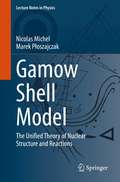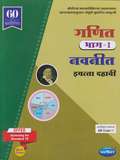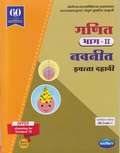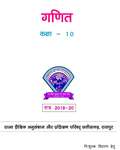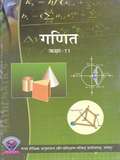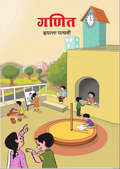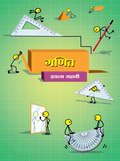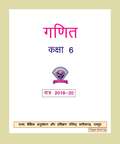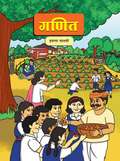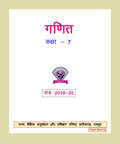- Table View
- List View
Games in Management Science: Essays in Honor of Georges Zaccour (International Series in Operations Research & Management Science #280)
by Pierre-Olivier Pineau Simon Sigué Sihem TaboubiThis book covers a large spectrum of cutting-edge game theory applications in management science in which Professor Georges Zaccour has made significant contributions. The book consists of 21 chapters and highlights the latest treatments of game theory in various areas, including marketing, supply chains, energy and environmental management, and cyber defense. With this book, former Ph.D. students and successful research collaborators of Professor Zaccour wish to honor his many scientific achievements.
Games, Norms and Reasons: Logic at the Crossroads (Synthese Library #353)
by Johan van Benthem, Amitabha Gupta and Eric PacuitGames, Norms, and Reasons: Logic at the Crossroads provides an overview of modern logic focusing on its relationships with other disciplines, including new interfaces with rational choice theory, epistemology, game theory and informatics. This book continues a series called "Logic at the Crossroads" whose title reflects a view that the deep insights from the classical phase of mathematical logic can form a harmonious mixture with a new, more ambitious research agenda of understanding and enhancing human reasoning and intelligent interaction. The editors have gathered together articles from active authors in this new area that explore dynamic logical aspects of norms, reasons, preferences and beliefs in human agency, human interaction and groups. The book pays a special tribute to Professor Rohit Parikh, a pioneer in this movement.
Games to Play and Games not to Play: Strategic Decisions via Extensions of Game Theory (Studies in Systems, Decision and Control #469)
by Uri Weiss Joseph AgassiThis book contributes to the theoretical discussions of equilibria that rest on error―in which we include mistaken choices of games to play. Extant game theory recommends diverse strategies (plans of actions) for various given games, particularly those in Nash equilibria, in which no player benefits from one-sided strategy alteration. The literature also refers to the design of games that fit given goals. This is the mechanism design theory; its function is to serve social planners ignorant of the preferences of the people intended to play them.Our study of games avoidance adds to game theory the meta-game of choosing what game to play and what game to avoid playing, and that both players and planners can generate. This comprises a shift from the maximalist position that aims to maximize possible profit to the minimalist one that aims at minimizing possible loss. This shift depends on the question, considering the public interest, what set of games is it advisable to encourage? Obviously, it is advisable to encourage playing some groups of games such as trade, as well as to discourage playing other groups of games such as wars. This shift makes the theory much more applicable to social science: usually, choosing what game to play is less practical than choosing what game not to play. This invites legislation and similar incentives; their study should aim at the improvement of their usefulness.Discussing the possibility of changing both game and strategy renders game theory part-and-parcel of social science. For this mathematical models will not do: it requires a clear distinction between describing options and explaining situations. Explanations may enhance efforts at improvement.
Games: Unifying Logic, Language, and Philosophy (Logic, Epistemology, and the Unity of Science #15)
by Ondrej Majer Ahti-Veikko Pietarinen Tero TulenheimoOndrejMajer,Ahti-VeikkoPietarinen,andTeroTulenheimo 1 Games and logic in philosophy Recent years have witnessed a growing interest in the unifying methodo- gies over what have been perceived as pretty disparate logical ‘systems’, or else merely an assortment of formal and mathematical ‘approaches’ to phi- sophical inquiry. This development has largely been fueled by an increasing dissatisfaction to what has earlier been taken to be a straightforward outcome of ‘logical pluralism’ or ‘methodological diversity’. These phrases appear to re ect the everyday chaos of our academic pursuits rather than any genuine attempt to clarify the general principles underlying the miscellaneous ways in which logic appears to us. But the situation is changing. Unity among plurality is emerging in c- temporary studies in logical philosophy and neighbouring disciplines. This is a necessary follow-up to the intensive research into the intricacies of logical systems and methodologies performed over the recent years. The present book suggests one such peculiar but very unrestrained meth- ological perspective over the eld of logic and its applications in mathematics, language or computation: games. An allegory for opposition, cooperation and coordination, games are also concrete objects of formal study.
Gamification in Education and Business
by Torsten Reiners Lincoln C. WoodThis book is dedicated to applied gamification in the areas of education and business, while also covering pitfalls to avoid and guidelines needed to successfully implement for a project. Using different theoretical backgrounds from various areas including behavioral economics, game theory, and complex adaptive systems, the contributors aim to help readers avoid common problems and difficulties that they could face with poor implementation. The book’s contributors are scholars and academics from the many areas where the key theory of gamification typically comes from. Ultimately, the book’s goal is to help bring together the theories from these different disciplines to the field of practice in education and business.The book is divided into four parts: Theory, Education, Business, and Use Cases. Part I provides a foundation on the theory of gamification and offers insight into some of the outstanding questions that have yet to be addressed. In Part II, the application and value that gamification can bring within the education sector is examined. The book then changes focus in Part III to spotlight the use of gamification within business environments. The topics also cover educational aspects like improved learning outcomes, motivation, and learning retention at the workplace. Finally Part IV concentrates on the applications and use of gamification through a series of case studies and key elements that are used in real situations to drive real results.
Gamification of Life and the Gaming Society: The Ludic Century (SpringerBriefs in Education)
by Fabian Arlt Hans-Jürgen ArltThis interesting book discusses why, as an activity, topic and metaphor, play and game have become an integral part of modern life. Empirically exemplary and theoretically grounded, this book discusses the developments and expansions in gaming, from easily accessible casual games to the galaxy-spanning gaming worlds of Massively Multiplayer Online Role-Playing Games (MMORPGs). It shows how gaming has become a focal point of the entertainment industry, marked by boundless professionalization and monetization, especially in the realm of sports, and how games become global platforms for social networks, where players from all over the world meet in digital sandboxes. The combination of the virtual and the ludic creates hyperreal spaces in which people try out new forms of interaction, cooperation, and even brainstorming. The authors ask if this behavior has become the new way of life and the new normal, and if this heralds the ludic century. They take readers on a journey to understand the dynamics of today's gaming society, and base their observations and analyses on an original theory of play, which, in contrast to social normalcy, revolves around the allure and threats of the unexpected. This book is of interest to students and researchers of social science and communication studies, especially those working on the interface of AI and society.
Gamification und Serious Games: Grundlagen, Vorgehen und Anwendungen (Edition HMD)
by Susanne Strahringer Christian LeyhDas Herausgeberwerk zeigt, wie das weitverbreitete Einbinden von Spielmechaniken in Softwaresysteme als auch das Spielen im betriebswirtschaftlichen Kontext zielgerichtet gestaltet und eingesetzt wird. Welche Herausforderungen dabei zu meistern sind, schildern verschiedene Autoren aus Wissenschaft und Praxis. Ein umfassendes Werk, das sich in erster Linie an Praktiker richtet, aber auch viel Wissenswertes für Lehrende an Universitäten und Hochschulen bietet.
Gaming as a Cultural Commons: Risks, Challenges, and Opportunities (Translational Systems Sciences #28)
by Toshiko Kikkawa Willy Christian Kriz Junkichi SugiuraThis book focuses on relatively neglected areas of simulation and gaming (S&G), i.e., cultural aspects and ethical issues, in addition to giving readers a basic knowledge of S&G. Although the educational effects of S&G, and related methods such as gamification, as well as serious games have been studied and are gaining recognition, their downsides are often overlooked. For example, there is always a risk of manipulation by games if maliciously designed and facilitated. Ethical codes of game designers, facilitators, and educators must be established on the basis of academic research. Considerations of the ethics of games are essential not only for S&G researchers and educators but also for the general public, because games have sometimes been used for propaganda purposes in the past and could be again, in the present and future. Looking at the cultural aspect, as the S&G community has accumulated research over 50 years, the book includes the knowledge of the pioneers, i.e., archival interview data. This is the first book that includes extensive interviews of researchers and commercial game designers and critics. It also contains diverse topics from the perspective of gender and Japanese culture. Japan has been attracting attention in the field of board games as there are many independent game designers and an expanding market. Although women in S&G have gained some recognition, the topic has been rather ignored and was first officially discussed in 2019 at the international conference of the International Simulation and Gaming Association held in Warsaw. In summary, by focusing on comparatively overlooked or neglected aspects of S&G, this book expands future opportunities in the field for researchers and educators, with increased awareness by the general public.
Gamma: The 3rd Book of Mathsteasers
by Tony GardinerThis question book uses the knowledge learnt in Year 6 to challenge advanced learners to think more deeply. The problems are tricky and can be used to stretch older pupils until Year 8. It is a flexible resource designed to be used by any pupil having a clever day and looking for that extra challenge to today's lesson. The Mathsteasers Series follows the 2014 English National Curriculum so is a great addition to any maths mastery programme or to be used as an after-school activity. As an added bonus at the end of each chapter you can find full solutions to each problem.
Gamma: Exploring Euler's Constant
by Julian Havil Freeman DysonAmong the many constants that appear in mathematics, π, e, and i are the most familiar. Following closely behind is y, or gamma, a constant that arises in many mathematical areas yet maintains a profound sense of mystery. In a tantalizing blend of history and mathematics, Julian Havil takes the reader on a journey through logarithms and the harmonic series, the two defining elements of gamma, toward the first account of gamma's place in mathematics. Introduced by the Swiss mathematician Leonhard Euler (1707-1783), who figures prominently in this book, gamma is defined as the limit of the sum of 1 + 1/2 + 1/3 + . . . Up to 1/n, minus the natural logarithm of n--the numerical value being 0.5772156. . . . But unlike its more celebrated colleagues π and e, the exact nature of gamma remains a mystery--we don't even know if gamma can be expressed as a fraction. Among the numerous topics that arise during this historical odyssey into fundamental mathematical ideas are the Prime Number Theorem and the most important open problem in mathematics today--the Riemann Hypothesis (though no proof of either is offered!). Sure to be popular with not only students and instructors but all math aficionados, Gamma takes us through countries, centuries, lives, and works, unfolding along the way the stories of some remarkable mathematics from some remarkable mathematicians.
Gamma: Exploring Euler's Constant
by Julian Havil Freeman DysonAmong the many constants that appear in mathematics, π, e, and i are the most familiar. Following closely behind is y, or gamma, a constant that arises in many mathematical areas yet maintains a profound sense of mystery. In a tantalizing blend of history and mathematics, Julian Havil takes the reader on a journey through logarithms and the harmonic series, the two defining elements of gamma, toward the first account of gamma's place in mathematics. Introduced by the Swiss mathematician Leonhard Euler (1707-1783), who figures prominently in this book, gamma is defined as the limit of the sum of 1 + 1/2 + 1/3 + . . . Up to 1/n, minus the natural logarithm of n--the numerical value being 0.5772156. . . . But unlike its more celebrated colleagues π and e, the exact nature of gamma remains a mystery--we don't even know if gamma can be expressed as a fraction. Among the numerous topics that arise during this historical odyssey into fundamental mathematical ideas are the Prime Number Theorem and the most important open problem in mathematics today--the Riemann Hypothesis (though no proof of either is offered!). Sure to be popular with not only students and instructors but all math aficionados, Gamma takes us through countries, centuries, lives, and works, unfolding along the way the stories of some remarkable mathematics from some remarkable mathematicians.
The Gamma Ray Sky with Compton GRO and SIGMA (Nato Science Series C: #461)
by M. Signore P. Salati G. VedrenneThis volume consists of invited lectures and seminars presented at the NATO Advanced Study Institute "The Gamma Ray Sky with COMPTON GRO and SIGMA" , which was held at the Centre de Physique Theorique of Les Houches (France) in January / February 1994. The school has been planned by a Scientific Organizing Committee. It was organized with the aim of providing students and young researchers with an up-to-date account of the high-energy phenomena in the vicinity of compact objets and the diffuse gamma-ray backgrounds after the early results from the gamma-ray telescope SIGMA and the four instruments onboard COMPTON GRO (Gamma Ray Observatory) : BATSE (Burst and Transient Source Experiment),COMPTEL(Compto'l Telescope),EGRET (Energetic Gamma Ray Experiment Telescope) and OS SE(Oriented Scintillation Spectrometer Experiment) . It was attended by more than sixty researchers from many countries. The lectures and seminars represent a complete coverage of our present knowledge and understanding of: Gamma-ray backgrounds, Gamma-ray Burts,Active Galactic Nuclei,Galactic Compact Objects, Gamma-ray Spectroscopy, Instrumentation and observation techniques, etc ... Most of these lectures are reproduced in this volume. Unfortunately, a few lecturers have chosen not to submit their manuscript.
Gamow Shell Model: The Unified Theory of Nuclear Structure and Reactions (Lecture Notes in Physics #983)
by Nicolas Michel Marek PłoszajczakThis book provides the first graduate-level, self-contained introduction to recent developments that lead to the formulation of the configuration-interaction approach for open quantum systems, the Gamow shell model, which provides a unitary description of quantum many-body system in different regimes of binding, and enables the unification in the description of nuclear structure and reactions. The Gamow shell model extends and generalizes the phenomenologically successful nuclear shell model to the domain of weakly-bound near-threshold states and resonances, offering a systematic tool to understand and categorize data on nuclear spectra, moments, collective excitations, particle and electromagnetic decays, clustering, elastic and inelastic scattering cross sections, and radiative capture cross sections of interest to astrophysics. The approach is of interest beyond nuclear physics and based on general properties of quasi-stationary solutions of the Schrödinger equation – so-called Gamow states. For the benefit of graduate students and newcomers to the field, the quantum-mechanical fundamentals are introduced in some detail. The text also provides a historical overview of how the field has evolved from the early days of the nuclear shell model to recent experimental developments, in both nuclear physics and related fields, supporting the unified description. The text contains many worked examples and several numerical codes are introduced to allow the reader to test different aspects of the continuum shell model discussed in the book.
Ganit Bhag 1 Digest class 10 - Maharashtra Board Guide: गणित भाग 1 डाइजेस्ट इयत्ता 10वी - महाराष्ट्र बोर्ड मार्गदर्शन
by Shri Navneetगणित भाग 1 इयत्ता 10वी चे पुस्तक नवनीत एज्युकेशन लिमिटेडने मराठी भाषेमध्ये प्रकाशित केलेले आहे, या पाठपुस्तकामधे सहा पाठ व त्यांची प्रश्नोत्तरे आणि बोर्डाची कृतिपत्रिका दिलेली आहे. प्रत्येक प्रकरणाच्या सुरुवातीला दिलेल्या 'महत्त्वाचे मुद्दे' यात, प्रकरणामध्ये असलेल्या सर्व अभ्यासघटकांचा समावेश आहे. काही ठिकाणी मुद्द्यांच्या स्वरूपात, तर काही ठिकाणी तक्त्यांच्या स्वरूपात माहितीची मांडणी करण्यात आली आहे. पाठ्यपुस्तकात आलेले 'सांगा पाहू' किंवा 'थोडे आठवा' या बाबी ‘महत्त्वाचे मुद्दे' यांत समाविष्ट करण्यात आल्या आहेत. यातील प्रश्नांची उत्तरे मिळाल्यावर किंवा कृती केल्यावर, त्यानंतर दिलेल्या मुद्द्यांचे आकलन होणे खूपच सोपे होईल, हा त्याचा मुख्य उद्देश आहे.
Ganit Bhag 2 Digest class 10 - Maharashtra Board Guide: गणित भाग 2 डाइजेस्ट इयत्ता 10वी - महाराष्ट्र बोर्ड मार्गदर्शन
by Shri Navneetगणित भाग 2 इयत्ता 10वी चे पुस्तक नवनीत एज्युकेशन लिमिटेडने मराठी भाषेमध्ये प्रकाशित केलेले आहे, या पाठपुस्तकामधे सात पाठ व त्यांची प्रश्नोत्तरे आणि बोर्डाची कृतिपत्रिका दिलेली आहे. प्रत्येक प्रकरणाच्या सुरुवातीला दिलेल्या 'महत्त्वाचे मुद्दे' यात, प्रकरणामध्ये असलेल्या सर्व अभ्यासघटकांचा समावेश आहे. काही ठिकाणी मुद्द्यांच्या स्वरूपात, तर काही ठिकाणी तक्त्यांच्या स्वरूपात माहितीची मांडणी करण्यात आली आहे. पाठ्यपुस्तकात आलेले 'सांगा पाहू' किंवा 'थोडे आठवा' या बाबी ‘महत्त्वाचे मुद्दे' यांत समाविष्ट करण्यात आल्या आहेत. यातील प्रश्नांची उत्तरे मिळाल्यावर किंवा कृती केल्यावर, त्यानंतर दिलेल्या मुद्द्यांचे आकलन होणे खूपच सोपे होईल, हा त्याचा मुख्य उद्देश आहे.
Ganit class 10 - S.C.E.R.T. Raipur - Chhattisgarh Board: गणित कक्षा 10 - एस.सी.ई.आर.टी. रायपुर - छत्तीसगढ़ बोर्ड
by Rajya Shaikshik Anusandhan Aur Prashikshan Parishad Raipur C. G.गणित कक्षा 10 वी का राज्य शैक्षिक अनुसंधान और प्रशिक्षण परिषद् छत्तीसगढ़ रायपुर ने पुस्तक हिंदी भाषा में प्रकाशित किया गया है, इस पाठपुस्तक में गणित पढ़ने का मूल उद्देश्य गणित के नियमों का उचित स्थानों का अध्ययन किया गया है। दसवीं कक्षा में गणित विषय के अन्तर्गत इन्हीं गतिविधियों पर खास जोर दिया गया है, जहाँ विद्यार्थी समूह चर्चा करेंगे, किताब पढ़कर समझेंगे, करके देखेंगे, सवाल हल करेंगे, खुद नए सवाल बनाएँगे। गणित के तार्किक ढाँचे को समझना एवं कथनों को गणितीय ढंग से सिद्ध करना, गणित सीखने-सिखाने का एक अहम् पहलू है। इस किताब में गणितीय कथनों को जाँचने के तरीके पर जोर दिया गया है ताकि विद्यार्थी गणितीय कथनों को ऐसे ही मान लेने के बजाए उन्हें पहले सिद्ध करें, उसमें निहित तर्क को समझें, साथ ही जाँचने और सिद्ध करने में अंतर भी जान सकें। अतः आप कक्षा में विद्यार्थियों को नए कथन लिखने उन्हें स्वयं सिद्ध करने का ढंग ढूँढने या पहले किए गए प्रमेयों को पढ़कर समझने एवं समझाने के अवसर दें।
Ganit class 11 - S.C.E.R.T Raipur - Chhattisgarh Board: गणित कक्षा 11 - एस.सी.ई.आर.टी. रायपुर छत्तीसगढ़ बोर्ड
by Rajya Shaikshik Anusandhan Aur Prashikshan Parishad Chhattisgarh Raipur C.G.गणित कक्षा 11 वीं का राज्य शैक्षिक अनुसंधान और प्रशिक्षण परिषद् छत्तीसगढ़ रायपुर ने पुस्तक हिंदी भाषा में प्रकाशित किया गया है, इस पाठपुस्तक में पंधरह अध्याय दिये गये है, जिसमे हर अध्याय के विवरण कि व्याख्या कि गई है ।
Ganit class 3 - Maharashtra Board: गणित इयत्ता तिसरी - महाराष्ट्र बोर्ड
by Maharashtra Rajya Pathyapustak Nirmiti Va Abhysakram Sanshodhan Mandal Puneगणित इयत्ता तिसरी हे महाराष्ट्र राज्य पाठ्यपुस्तक निर्मिती व अभ्यासक्रम संशोधन मंडळ, पुणे यांनी या पुस्तकाचे लेखन केले आहे तसेच श्री. विवेक उत्तम गोसावी यांनी हे पुस्तक मराठी भाषेमध्ये प्रकाशित केले आहे. या पाठपुस्तकात गणित संबोधांची उजळणी व्हावी, त्यांचे स्थिरीकरण व्हावे, स्वयं-अध्ययन सुलभ व्हाव म्हणून पुस्तकात श्रेणीबद्ध (Graded) 'स्वाध्याय' आणि 'संवादांचा' समावेश करण्यात आला आहे. स्वाध्यायामधील प्रश्न विद्याथ्यानो स्वप्रयत्नाने सोडवावे अशी अपेक्षा आहे. स्वाध्याय कटाळवाण होऊ नयेत यासाठी त्यांमध्ये विविधता आणण्याचा प्रयत्न केला आहे.
Ganit class 4 - GSTB: ગણિત ધોરણ ૪ - જીએસટીબી
by Kinnariben Dave Dr Bharat J. Pathakપ્રસ્તુત પાઠ્યપુસ્તક ધોરણ ૪ ના ગણિત વિષયનું છે.
Ganit class 5 - Maharashtra Board: गणित इयत्ता पाचवी - महाराष्ट्र बोर्ड
by Maharashtra Rajya Pathyapustak Nirmiti Va Abhysakram Sanshodhan Mandal Puneगणित इयत्ता पाचवी हे महाराष्ट्र राज्य पाठ्यपुस्तक निर्मिती व अभ्यासक्रम संशोधन मंडळ, पुणे यांनी या पुस्तकाचे लेखन केले आहे तसेच श्री. विवेक उत्तम गोसावी यांनी हे पुस्तक मराठी भाषेमध्ये प्रकाशित केले आहे. या पाठपुस्तकात दोन विभागामध्ये सोळा प्रकरण व त्याचे उदाहरणसंग्रह दिलेले आहेत. या पाठपुस्तकात काही पाठांच्या संदर्भात शिक्षकांनी जी भाषा विद्यार्थ्यांसमोर मांडावी अशी अपेक्षा आहे, ती पाठ्यपुस्तकात संवादरूपात दिली आहे. ज्यांचा वापर विद्यार्थ्यांना गणिताच्या अभ्यासात वारंवार करावा लागतो, असे गुणधर्म व नियम चौकटींत दिले आहेत. तसेच, विचार करा, गणिती कोडी, शोधा म्हणजे सापडेल, खेळ यांचा वापर करून गणित विषय मनोरंजक करण्याचा प्रयत्न केला आहे. हे पाठ्यपुस्तक जास्तीत जास्त निर्दोष व दर्जेदार व्हावे, या दृष्टीने महाराष्ट्राच्या सर्व भागांतील निवडक शिक्षक, तसेच काही शिक्षणतज्ज्ञ व विषयतज्ज्ञ यांच्याकडून या पुस्तकाचे समीक्षण करून घेण्यात आले आहे.
Ganit class 6 - Maharashtra Board: गणित इयत्ता सहावी - महाराष्ट्र बोर्ड
by Maharashtra Rajya Pathyapustak Nirmiti Va Abhysakram Sanshodhan Mandal Puneगणित इयत्ता सहावी हे महाराष्ट्र राज्य पाठ्यपुस्तक निर्मिती व अभ्यासक्रम संशोधन मंडळ, पुणे यांनी या पुस्तकाचे लेखन केले आहे तसेच श्री. विवेक उत्तम गोसावी यांनी हे पुस्तक मराठी भाषेमध्ये प्रकाशित केले आहे. या पाठ्यपुस्तकामध्ये अध्ययन-अध्यापन प्रक्रिया विद्यार्थीकेंद्रित असावी, स्वयंअध्ययन प्रक्रियेवर भर दिला जावा, तसेच शिक्षणाची प्रक्रिया रंजक आणि आनंददायी व्हावी हा दृष्टिकोन समोर ठेवून या पुस्तकाची रचना करण्यात आली आहे. पाठ्यपुस्तकात भूमिती, संख्याज्ञान, संख्याप्रणाली, अपूर्णांक, बीजगणित, व्यावहारिक गणित, माहितीचे व्यवस्थापन या क्षेत्रांमध्ये समाविष्ट असलेल्या संकल्पना सोप्या भाषेत स्पष्ट केल्या आहेत. प्रत्येक पाठ्यघटकाच्या शेवटी सरावासाठी सरावसंच दिले आहेत. या सरावसंचातील उदाहरणांची उत्तरे पाठ्यपुस्तकाच्या शेवटी दिली आहेत. तसेच अध्ययन-अध्यापन प्रभावी होण्यास उपयोगी पडतील असे ‘आय.सी.टी. टूल्स' यांचा समावेश पाठ्यपुस्तकात केला आहे.
Ganit class 6 - S.C.E.R.T. Raipur - Chhattisgarh Board: गणित कक्षा 6 - एस.सी.ई.आर.टी. रायपुर - छत्तीसगढ़ बोर्ड
by Rajya Shaikshik Anusandhan Aur Prashikshan Parishad Raipur C. G.गणित पाठ्यपुस्तक कक्षा 6 वी का राज्य शैक्षिक अनुसंधान और प्रशिक्षण परिषद् छत्तीसगढ़ रायपुर ने हिंदी भाषा में प्रकाशित किया गया है, इस पाठ्यपुस्तक में समूह में वस्तुओं की संख्या, प्राकृत संख्याओं की समझ व उन पर हुई सामान्य संक्रियाओं से आगे बढ़कर संख्याओं का सामान्य प्रतिरुपण व नियम, चर की अवधारणा, सिद्ध करने की धारणा, व्यापीकृत नियमों, व्यवहारिक गणित, आदि के बारे में सीखेंगे। इसके साथ-साथ हमे आकृतियों की रचना, प्रकार व आकार के बारे में समझाने का प्रयास किया गया है। इस विषय में हमे आंकड़ो को व्यवस्थित करके प्रस्तुत करना और उनसे निष्कर्ष निकालना भी सीखाया गया है।
Ganit class 7 - Maharashtra Board: गणित इयत्ता सातवी - महाराष्ट्र बोर्ड
by Maharashtra Rajya Pathyapustak Nirmiti Va Abhysakram Sanshodhan Mandal Puneगणित इयत्ता सातवी हे महाराष्ट्र राज्य पाठ्यपुस्तक निर्मिती व अभ्यासक्रम संशोधन मंडळ, पुणे यांनी या पुस्तकाचे लेखन केले आहे तसेच श्री. विवेक उत्तम गोसावी यांनी हे पुस्तक मराठी भाषेमध्ये प्रकाशित केले आहे. पाठ्यपुस्तकात काही कृती व रचना दिल्या आहेत त्या जरूर करून पाहा. त्यामधून काही गंमत, नवे गुणधर्म लक्षात येतात का ते पाहा. आपापसात चर्चा करून नवे मुद्दे समजू शकतात. चित्रे, वेन आकृत्या व इंटरनेटच्या साहाय्याने गणित समजणे सोपे होते. हे मुद्दे नीट समजले तर गणित मुळीच अवघड नाही. पाठ्यपुस्तकातील प्रत्येक प्रकरण तुम्ही नीट लक्ष देऊन वाचावे अशी अपेक्षा आहे. गणित सोडवण्याची रीत तसेच त्याचे सूत्र का व कसे तयार झाले याचे स्पष्टीकरण या पुस्तकात दिले आहे. त्या रीती वापरून उदाहरणे सोडवण्याचा सराव करा. तो महत्त्वाचा आहे. सरावसंचात दिलेल्या उदाहरणासारखी जास्तीची उदाहरणे तुम्हीही तयार करा. अधिक आव्हानात्मक उदाहरणे या पाठ्यपुस्तकात तारांकित करून दिली आहेत.
Ganit class 7 - S.C.E.R.T. Raipur - Chhattisgarh Board: गणित कक्षा 7 - एस.सी.ई.आर.टी. रायपुर - छत्तीसगढ़ बोर्ड
by Rajya Shaikshik Anusandhan Aur Prashikshan Parishad Raipur C. G.गणित कक्षा 7 वी का राज्य शैक्षिक अनुसंधान और प्रशिक्षण परिषद् छत्तीसगढ़ रायपुर ने पुस्तक हिंदी भाषा में प्रकाशित किया गया है, इस पाठपुस्तक में गणित पढ़ने का मूल उद्देश्य गणित के नियमों का उचित स्थानों का अध्ययन किया गया है। कक्षा 7 में गणित विषय के अन्तर्गत सामन्य तौर पर संख्याओं, उनके गुणों व पारस्परिक संबंधों के साथ-साथ, आस-पास के स्थान की समझ को व्यवस्थित कर उसमें सर्वांगसमता, कोण व अंकन, परिमाण तथा अन्य इसी प्रकार के मापों का समावेश किया गया है।
Ganit class 8 - GSTB: ગણિત ધોરણ ૮ - જીએસટીબી
by Gstbઆ પાઠ્ય પુસ્તકનો અનુવાદ તથા તેની સમીક્ષા નિષ્ણાત પ્રાધ્યાપકો અને શિક્ષકો પાસે કરાવવામાં આવ્યા છે અને સમીક્ષકોનાં સૂચનો અનુસાર હરતપ્રતમાં યોગ્ય સુધારા - વધારા કર્યા પછી આ પાઠયપુસ્તક પ્રસિદ્ધ કરવામાં આવેલ છે. જેમાં ૧૬ પ્રકરણ અને સ્વાધ્યાય આપેલ છે.
